Ceramic bone substitute material and method for the production thereof
a technology of ceramic bone and substitute material, which is applied in the direction of ceramicware, prosthesis, other domestic articles, etc., can solve the problems of adverse high risk of infection during surgery, and negative effects on human organisms, and achieve high porosity and adequate strength
- Summary
- Abstract
- Description
- Claims
- Application Information
AI Technical Summary
Benefits of technology
Problems solved by technology
Method used
Image
Examples
Embodiment Construction
[0041]A method according to the invention for producing bone substitute material that comprises at least one porous ceramic osseoconductive part thus includes at least the following steps:
a) providing a foam or an open-cell foam structure;
b) preparing a ceramic infiltrate suspension;
c) infiltrating the foam with the ceramic infiltrate suspension;
d) debinding the ceramic material and burning out the foam; and
e) sintering.
[0042]The bone substitute material according to the invention comprises at least one porous ceramic osseoconductive part, which is characterized by having an open-pore, honeycomb-like cell structure.
[0043]An open-pore, honeycomb-like cell structure within the scope of the present invention shall be understood to mean an interconnecting porosity that provides a framework for new bone growth, which is to say acts osseoconductively. Structures that are essentially based on strut-like frameworks made of tantalum, or structures that are based on solid ceramics having a pl...
PUM
| Property | Measurement | Unit |
|---|---|---|
| temperature | aaaaa | aaaaa |
| temperature | aaaaa | aaaaa |
| temperatures | aaaaa | aaaaa |
Abstract
Description
Claims
Application Information
 Login to View More
Login to View More - R&D
- Intellectual Property
- Life Sciences
- Materials
- Tech Scout
- Unparalleled Data Quality
- Higher Quality Content
- 60% Fewer Hallucinations
Browse by: Latest US Patents, China's latest patents, Technical Efficacy Thesaurus, Application Domain, Technology Topic, Popular Technical Reports.
© 2025 PatSnap. All rights reserved.Legal|Privacy policy|Modern Slavery Act Transparency Statement|Sitemap|About US| Contact US: help@patsnap.com



